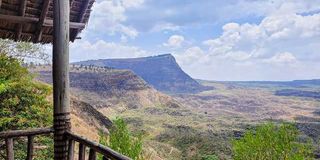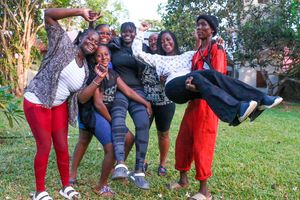Breaking News: Former Lugari MP Cyrus Jirongo dies in a road crash
Premium
At Maili Saba Camp, a place with a story to tell

The Maili Saba Camp near Nakuru.
We thought it would be a good idea to get away for a weekend, not so much away from the frenetic city but away from TVs, radios and the internet that for weeks have been talking about little else than the mayhem being caused across the world by the second coming of Trump.
Friends of Lut had recently stayed at the Maili Saba Camp that is just south of Nakuru, and they recommended it as a pleasant and peaceful place – the kind of place we were looking for. So, we went there last weekend.
To get to the camp, you turn off the main road a few kilometres short of Nakuru Town, taking the B5 Solai Road to Maili Saba. The camp is on the edge of the Menengai Caldera – the huge cauldron-like hollow that was formed when a magma chamber emptied during a volcanic eruption. Our room, a cross between a tent and a banda, was right on the rim of the caldera, with a view across the lava-strewn saucer. I had been to Menengai twice before.
In 1969, I took a photograph of the Solai Valley from the high point of the caldera, where there is a signpost noting the distances to many places across the world. At that time, it was not easy to spot any buildings in the valley. When I took the second photograph in 1988, the valley was a place of many homesteads and fertile shambas. Our current photographs of the crater show structures harvesting geothermal energy. Unfortunately, none of the ghosts that are said to haunt the place showed up in our photographs – ghosts of the many Maasai that were killed there in a massive inter-clan battle.
On arrival at the camp, we were greeted by James Karaya, the manager, who then introduced us to Milka and Monica, who would be looking after us for our one-night stay. It was lunchtime, so after being escorted to our room, we went back to the main building and its restaurant and bar. My standout memory of that first meal was of the starter salad – an impressive cocktail of sautéed vegetables and cashew nuts. Another highlight was the spicy pumpkin soup served at dinner. Otherwise, the food was fairly simple and certainly substantial. In the evening, I discovered that Milka could mix an excellent gin and tonic.
Our room was quite spacious, with a comfortable bed, separate and screened shower, toilet and hand-basin spaces. It was a family room, so it had a second bedroom with three single beds. On the wooden balcony, two chairs and a coffee table were set out to enjoy the fresh air and, of course, the view. There were baboons down in the caldera, but an unobtrusive electric fence prevented them from raiding the rooms. But the fence couldn’t keep away the birds.
We saw a pair of uncommon Hemprich’s hornbills, which our bird book says are found in rocky parts of northern Kenya, but often wanders to Menengai Crater. Found anywhere, there were scraps-hunting starlings, weaver birds and a pretty cordon-bleu.
After lunch, Lut went on a guided walk to see the camp’s surroundings, as I settled to a talk with James.
He had a very important story to tell. Maili Saba Camp belongs to the NGO, Ujima Foundation for Training and Development. Its objective is to support orphaned youngsters, mainly girls, who have the challenging responsibility of looking after their siblings.
In Nakuru and Kisumu, it provides a six-month training programme – three months training and three months placement – that prepares them for employment in, particularly, the hospitality industry. Since its foundation in 2004, Ujima has reached a point where it trains about 400 participants a year. Given the unemployment situation in Kenya, I asked James how difficult it is to find jobs for the graduates of the programme. He said that the record is very good because, in both Nakuru and Kisumu, the programme has a very good reputation, and they have managed to establish relationships with many hotels and restaurants.
The Maili Saba Camp supports the NGO, in that all profits from the business go towards financing the programme. And the camp is a place where a number of the trainees can practise and hone their skills. Right now, a new training centre is being built at the camp. Also, in January 2024 in Kisumu, the Ujima Food Garden Restaurant was opened.
As I said, we thought we were getting away from all the talk about the chaos and damage Trump is causing, but James told us that what has happened to USAID is threatening the survival of some of the international NGOs that contribute to the funding of the Ujima Foundation. What the NGO means to those who benefit from it, we understood more clearly after a conversation with Milka, who is herself a graduate of the programme.
She started working in the kitchen, before taking on her current role in what you might call a front-of-house position at the camp. This fits with what James told us about the way the organisation promotes the continuing growth of those who work for it. She rates Ujima very highly, and her gratitude for what it has done for herself and her family comes across very clearly.
Those who stay at the Maili Saba Camp know that they are helping to support the Foundation. Our stay was a very short one, so we didn’t have the time to take up some of the activities on offer. For example, you can relax at, or in, the small swimming pool. You can enjoy a green tea footbath and massage, a Swedish massage, a manicure and a pedicure at the beauty therapy parlour. Or you can go on one of the fairly strenuous hikes around or down into the caldera.
John Fox is Chairman of iDC Email: [email protected]





